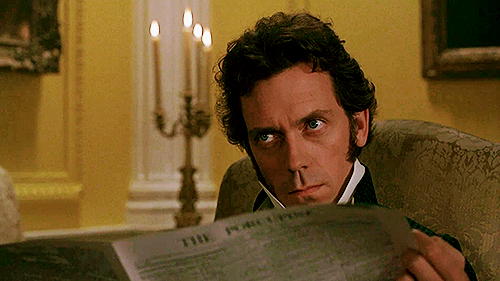
It’s not unusual to see facsimile newspapers as props in period dramas, both on television and in film. Quite often, these don’t make any serious attempt to emulate the form taken by papers of the relevant era. This is something of a bugbear for cultural historians, though presumably the producers, as creators of fiction rather than documentary programmes, only feel the need to use recognisable props that broadly represent the historical period concerned.
Recently, I happened upon a television channel broadcasting (how quaint!) Ang Lee’s 1995 film adaptation of Sense and Sensibility. Watching it, I was struck by the fact that a relatively minor character, Mr Palmer (played by Hugh Laurie) was reading a copy of The Porcupine. As can be seen from this digital facsimile of the newspaper, the film’s production team created a commendably accurate version, with bold, capital type for the newspaper’s title, what look to be similar horizontal lines below the motto enclosing the bibliographical information, and four columns of typically densely-printed text. The newspaper was also four printed pages, comprising one sheet, folded, as in the film’s version.

What is of interest to me, unsurprisingly, is that The Porcupine was a short-lived newspaper that was only in print between 1800 and 1801 in London. It was the work of William Cobbett, a proprietor who had recently returned from the United States where his anti-republican, pro-Tory views under the soubriquet ‘Peter Porcupine’ had made him rather notorious. The prickly venture was much less enduring in the land of his birth, though Cobbett would later embrace the radical cause and continued to produce newspapers for many years. In any case, apart from press historians, few today have heard of The Porcupine. I am intrigued as to why it was chosen, when other papers were available from the late eighteenth or early nineteenth centuries whose titles still exist today, notably The Times, and The Observer.
On the one hand, this prop it gives a clear time stamp to the setting of the film adaptation, a little earlier than the publication of the novel in 1811, a little later than when Jane Austen is believed to have originally written it, in the late 1790s. It seems unlikely to have been chosen for this purpose, yet it is actually a paper from around the correct time. What proportion of the audience would know that is a moot point. Perhaps the answer is more prosaic; the character of Mr Palmer is rather abrupt – at least in his public guise – so the newspaper’s title might reflect that presentation of his character, although the glimpse of the paper is quite fleeting. Whatever the reason, it was very refreshing to see such a carefully-created mock-up of a real, short-lived early nineteenth-century newspaper. In this one little appearance, The Porcupine gained a kind of afterlife far beyond its original print run. In that way, it might stand for the press in general – as something simultaneously ephemeral and enduring.
I will admit to really enjoying the books and the film adapatations of Pride and Prejudice and Sense and Sensibility, Having watched these films many times I have to admit I have never given a second thought to the newspapers but reading your blog was so interesting and enjoyable. To find that a newspaper which was in print for a year has resurfaced in such an unexpected way is fascinating and adds that extra dimension to the success or failure of short lived papers. The meaning of success can be interpreter in so many ways. I really enjoy your blogs which have an element of humour within the interesting facts which are presented in such an engaging way, Your blog was recommended to me by a friend who is an academic and thought it might interest me. My studies have always been in the sciences but you have given me a new interest in history and the arts, I never fail to learn something new and look forward to reading more.